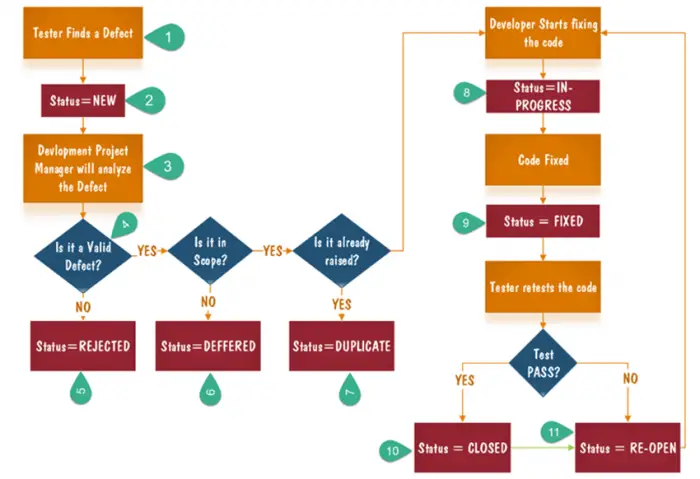
Bug Life Cycle in Software Testing (with Real-Time Scenarios)

☠️ There I was, 3 AM, knee-deep in the Bug Life Cycle in Software Testing…
…with Jenkins failing silently like my last relationship, test data doing the Macarena across environments, and a “minor UI change” nuking 62 Selenium scripts. The dev’s commit message? "Fixed stuff".
Bug tracking? Oh sure, we had Jira. We also had dreams. Neither worked consistently.
I opened a bug. Labeled it. Commented with repro steps so detailed they could file for citizenship.
Three days later?
“Can’t repro. Closing.”
Welcome to the Bug Life Cycle. Strap in. It’s flakey AF.
🧨 The Brutal Truth
The Bug Life Cycle is not a neat little flowchart on a PowerPoint slide.
It’s a raging, chaotic dance between denial, blame, and passive-aggressive comments in Jira.
Without understanding the Bug Life Cycle in Software Testing, you’re just opening bugs and hoping they disappear. But trust me, they don’t. A proper bug life cycle isn’t just a flowchart — it’s the foundation of good test management.
Here’s the actual cycle, with real-time scars to prove it:
🕳️ [Bug Life Cycle in Software Testing (with Real-Time Scenarios)] Myth-Busting
1. New
Reality: You log a bug. You’re hopeful. Naïve. The bug is “New,” like a puppy.
Cue devs ignoring it like a LinkedIn recruiter post for unpaid internships.
Real-Time Scenario: Logged a critical UI bug. Tooltip text missing. Design guy said it’s “intentional whitespace.”
Me: “Whitespace doesn’t clip text mid-sentence, Ravi.”
2. Assigned
Now the bug has a name tag. Great.
Except it’s assigned to the wrong dev.
Or worse, the right dev on PTO in Goa until Q4.
3. Open
Here’s where the gaslighting starts.
“Works on my machine.”
“It’s a cache issue.”
“Try in incognito.”
“Do you even test, bro?”
Yeah, I test. I test my patience daily.
4. In Progress
Translation:
“I saw your bug, made a new branch, and forgot about it.”
5. Fixed
Ah yes. “Fixed.”
But no mention of how.
No link to commit.
No test added.
No PR review.
Just “Fixed.”
That time a dev marked a performance bug as fixed by commenting out the test case?
I wept in legacy CSS.
6. Ready for QA
Which really means:
“It builds now. You figure out if it’s fixed.”
Here comes your spiritual trial.
Manual regression, API re-checks, browser matrix testing.
checks phone
Sorry, my cat just knocked over my coffee. Probably still more useful than half the unit tests.
7. Reopened
You dare reopen a bug?
Prepare for the 7 stages of Dev Grief:
Denial. Anger. Blame. “Let’s sync offline.”
Real-Time Scenario: I reopened a “fixed” bug because it still crashed on Safari.
Dev: “Nobody uses Safari.”
Me: “Apple says 18% of the world does.”
Dev: blocks me on Slack
8. Closed
It’s either actually fixed…
Or you gave up.
And if it’s Closed without test automation coverage?
Congratulations. You’re gonna see it again in Prod, wearing a new hat.
🧠 When “Alternative Truths” Actually Work
You know what’s actually hurting your QA outcomes?
👉 Over-documenting trivial bugs instead of fixing your flaky test infra.
👉 Chasing “100% automation” like it’s Nirvana.
👉 Trusting self-healing locators like they’re magic. (Spoiler: They’re not. They’re regex with a midlife crisis.)
What does work?
-
Pairing with devs. Yeah, actual human interaction.
-
Logging bugs with screenshots, logs, and reproducible steps.
-
And my personal favourite:
Attaching memes to Jira tickets. Because if you’re gonna suffer, be memorable.
🔥 Nuclear Hot Take: AI Testing Is Just Regex with a Marketing Degree
There. I said it.
“AI-powered testing” tools are mostly glorified record-and-playbacks with a GPT wrapper and a pricing model designed to bankrupt your QA budget faster than crypto in 2022.
Remember TestProject? Dead.
Remember Katalon? Bloated.
Remember your own custom framework you swore you’d maintain? Yeah, me neither. Pours one out for that GitHub repo with 97 stars and no readme.
You want resilient automation?
Learn selectors. Master your waits. Version your damn test data.
🥊 CTA That Starts Fights
Are we really closing bugs, or just hiding them under process theater?
Tell me, what’s worse:
-
A bug slipping into prod?
-
Or spending 6 hours updating the “Repro Steps” field because your PM wants “consistency”?
I’ll wait.
🛑 Before You Go
Remember when we used to write test cases in Excel?
Yeah. Dark times.
But at least Excel never gaslit me with, “Can’t repro.”
And if anyone says, “Let’s just use ChatGPT to write test cases”—
You have my permission to throw the nearest ergonomic keyboard at them.
🐍 Final Thought:
The Bug Life Cycle isn’t a process. It’s a soap opera.
The best you can do is document well, automate wisely, and never trust a green Jenkins job without checking the logs.
Or as I like to say:
“Every closed bug is a sleeper agent.”
Sleep tight.